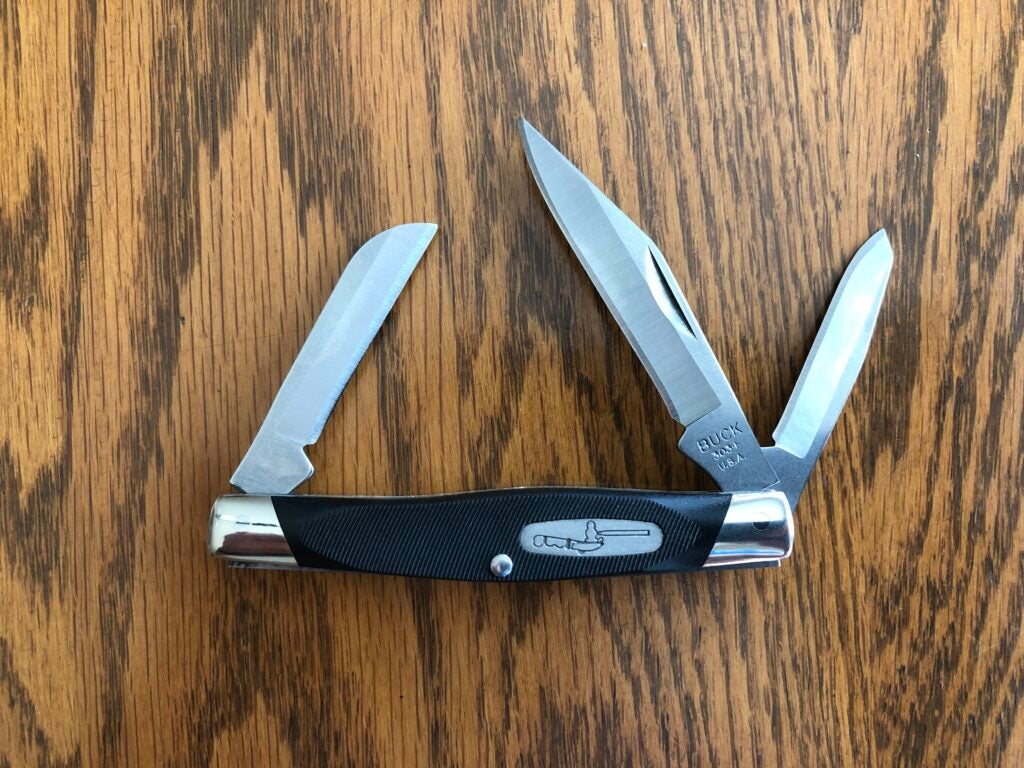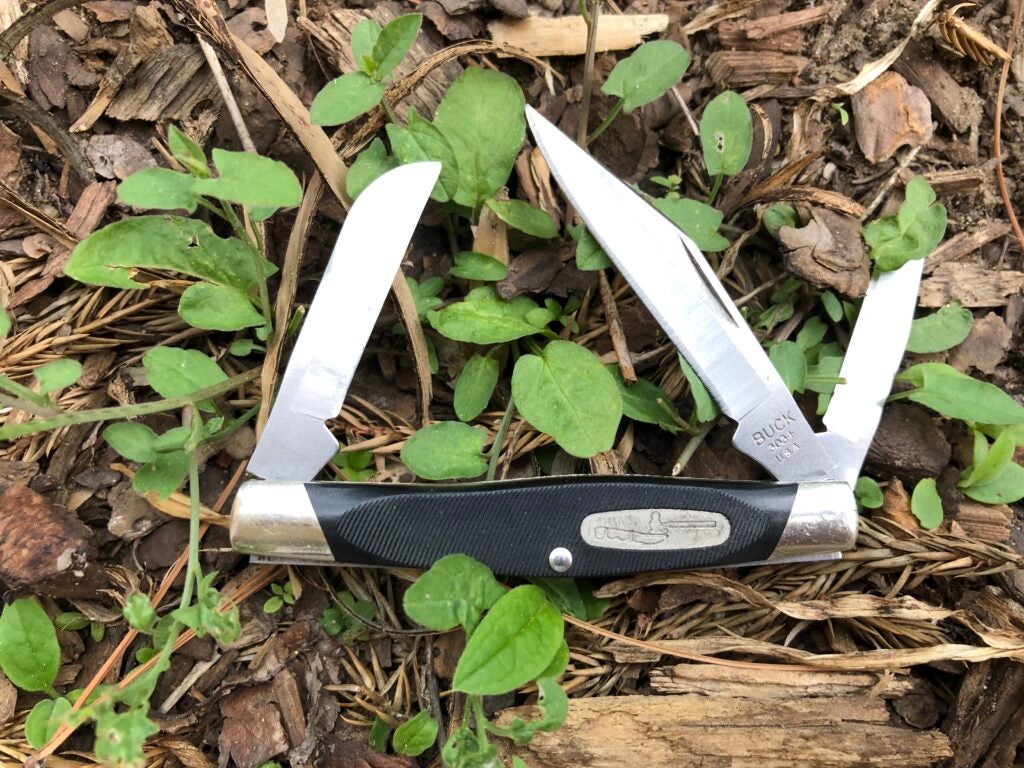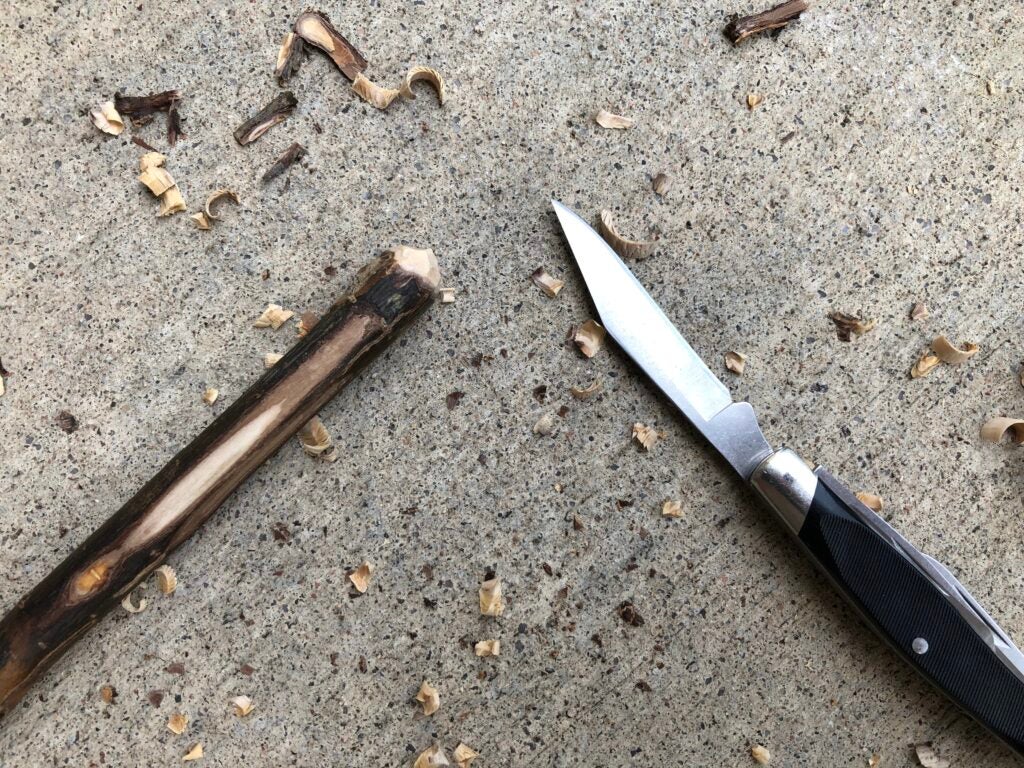Pocket knives equal America, plain and simple. Sure, plenty of nations and peoples are known for their own unique take on cold, hard steel, but none have mastered the pocket knife quite like the country known for baseball, rock and roll, and the legendary .50 cal Ma Deuce. Pocket folders are an American staple, and nothing is quite as patriotic as flipping open a classic slip joint whenever a job calls for a slice of steel.
Enter the Buck Knives 303 Cadet. Slip joint knives may have lost some ground to more safety-conscious locking blades, but for quick and easy jobs, nothing works quite as well as a classic. During World War II, knives like the Buck Cadet saw action in the Sahara, traversed the Alps, and accompanied amphibious Marines across countless Pacific islands. Sure, the Ka-Bar stole the show and our memories, but for most, the knives that came home again were slip joints that provided decades of silent service.
Folding knives like the 303 Cadet fill the role of constant sidekick and often complement another knife dedicated to a different role. While big boys like the Ka-Bar serve as cold steel life preservers, pocket folders like the Cadet take care of the little things, the tedious things, and the mundane things. Sure, you could open boxes with seven inches of 1095 Cro-Van steel, but that’s about as practical as launching a tactical nuke at the anthill in your backyard. Small folding knives like the Cadet serve as dignified, practical tools that won’t make you look like a tool while using it.
To most, the Buck 303 may not be the most exciting knife on the market, but it definitely shapes up as the right tool for most EDC jobs — and at just over $50, it’s one of the more moderately-priced folders on the market.
Blade lengths: 2.5 in (clip), 1.75 in (sheepsfoot), 1.68 in (spey)
Weight: 1.9 oz
Material: 420HC stainless steel (blades), Valox or rosewood with nickel silver bolsters (handle)
Unboxing
The 303 Cadet comes tucked inside classic Buck Knives packaging, a yellow and black paperboard box with Old Glory and the words “USA Made” boldly stamped on one end. The Cadet’s packaging is simple, straightforward, and eye-catching. Nicely done, Buck.

Upon opening the box, I found myself somewhat disappointed by the non-traditional looks of the knife that slid out into my hand. The Cadet looking back at me was a basic, good-looking knife with black Valox scales and silver nickel bolsters. It looked like a miniature Stockman (which it is), but it lacked the traditional wood and brass combination I have come to love about classic Buck knives. That said, this Cadet’s textured black scales provide a very good grip, and the fit and finish are excellent. The Cadet may not be as fun to play with as the 371 Stockman I reviewed earlier but is the perfect size for pocket carry.

The Buck 303 Cadet lacks the size and weight to earn a “bulky” classification. Measuring at only 1.9 ounces and 3.25 inches long while closed, it is extremely comfortable and convenient for everyday carry. Each of the three blades consists of 420HC stainless steel finished with Buck Knives’ proprietary heat treatment. The knife possesses a 2.5-inch clip point, a 1.75-inch sheepsfoot, and a 1 11/16-inch spey point blade, making it a miniature version of Buck’s 371 and 301 Stockman models.
How we tested the Buck 303 Cadet
Whenever I receive a new blade to review, I always try to structure my tests for the knife to replicate or simulate common tasks a user might ask of it. For the Buck Cadet, I conducted four main tests: paper, carry/EDC, stick, and sharpening. The paper and sharpening tests are my defaults for any blade, while the other two are specific to EDC and outdoor knives such as the Cadet.
Upon unboxing the Buck 303, I immediately conducted a paper test, comparing it to my handy Buck 110 which is sharpened slightly beyond the standard Buck factory edge. To maintain an apples-to-apples comparison, I only used a portion of the 110’s edge, matching it to the lengths of all three blades the Cadet sports. Predictably, each of the 303’s blades produced slightly shallower cuts than the 110’s blade under the same pressure and momentum.
Once this test was completed, I immediately slipped the Cadet into my pocket, initiating the carry test. For the next two weeks, the Cadet disappeared into my pocket, only coming out to complete some traditional EDC tasks. I opened and tore down boxes, removed staples, scraped crud off a glass stovetop, and completed whatever other odd tasks came my way. During this two-week period, I frequently wore basketball shorts with slick pockets and only once lost the knife while laying on my couch. (To be fair, I have lost virtually every other clipless knife I’ve ever carried while lounging on the couch in basketball shorts.)

After some time in my pocket, the 303 Cadet left my EDC rotation to undergo the stick test. In short, this test involves a bit of whittling with hardwoods to reveal how comfortable and usable the knife is for basic woodworking tasks and how well the blade holds its edge under heavier use. To avoid redundancy during this test, I stuck with the larger clip point blade, knowing the blade quality on both the spey and the sheepsfoot would be comparable. The knife performed pretty well, proving both comfortable in my hand and easy to use and control during both short and long strokes. That said, toward the end of the testing session, my thumb was really starting to feel the 90-degree corner on the spine, a temporary malady that lasted throughout the late afternoon and evening following the test.
To wrap things up, I showed the Cadet’s much-used clip point a little love with the sharpening test. I picked up my ever-present Smith’s DRET (a semi-permanent resident of my writing desk) and gave the Cadet’s clip point a good 30ish strokes under medium pressure, surpassing its factory edge and even a little past that of my recently-sharpened 110. (While the DRET may not deliver the finest edge in the world, its medium grit is perfect for getting any knife up to snuff in a hurry.) The Cadet’s clip point provided little resistance, taking the new edge quickly and easily.

What we like about the Buck 303 Cadet
There’s a lot to like about the Buck Cadet within the parameters of its design. It is an EDC knife, and it pulls off the role very well, starting with its pocket-friendly size and weight. Measuring at less than 3.5 inches long and tipping the scales at under two ounces, this classic American knife slips smoothly into pockets and disappears without a trace. When you find yourself needing it, the blades are easy to deploy, and the black Valox scales on my knife provide a very good grip thanks to the deep, fine grooves along the length of each scale. In short, the 303 just feels right and is perfect in the traditional EDC role.
Like all Buck knives, the 303 Cadet comes with a very good edge straight from the factory and maintains its level of sharpness quite well for a budget blade steel. The combination of three blades offers a nice degree of versatility, although I must say that I kept finding myself using the clip point while the other two blades got somewhat forgotten, especially the spey. I can see a handful of practical uses for the sheepsfoot, but in my mind, the spey blade seems a bit small to be particularly useful. Obviously, this will vary based on the individual user, but either way, multiple blades can be a very nice feature on an EDC knife, especially if you prefer to use specific blades for specific tasks, such as an ultra-fine sheepsfoot for shaving (?!).
Finally, I do like the aesthetics of the Buck Cadet. While I certainly prefer the look of the brass and rosewood option, the black and silver blade I received could have its own utilitarian appeal for some. Add to that the excellent fit and finish (an almost mundane feature on classic Buck Knives), and there’s little to dislike about the look of this knife.

What we don’t like about the Buck 303 Cadet
As handy as it is, the Buck Cadet does have a few shortcomings, particularly its size. Yeah, yeah, I know I said its size was in its favor, but the 303 also suffers from its diminutive blades. The small size is excellent for everyday carry, but the smaller blades have limited value in certain situations, particularly in the outdoors. The Cadet excels primarily in a basic EDC knife or as a casual whittling blade, but for more intensive tasks it may fall short.
While it may not be the cheapest blade on the market, the 303 Cadet is still quite affordable thanks mainly to Buck’s use of budget-level 420HC stainless steel. While the manufacturer’s proprietary heat treatment certainly gives its blades a significant durability boost over knives made with the same steel, 420HC simply does not hold an edge well over time or under hard use. Unlike the 110 and select few other Buck knives, the 303 lacks any other blade steel options, meaning Cadet owners should invest in a whetstone or other knife sharpener and take the time to learn how to properly sharpen a knife.
Verdict
Few knives fit the description “quintessential” like the Buck 303 Cadet. If you are a traditionalist or simply want a small, lightweight EDC blade, then the Cadet might be a solid choice. Like with all entry-level Buck blades, you’ll want to make sure you learn how to sharpen the 303 when it dulls, or you may choose to buy two and alternate shipping them off to the factory for a free sharpening session.
I’ve been a fan of Buck Knives for years, and that love has been earned within the context of what Buck’s products are designed to be: quality, low-cost blades that are built to last. The Cadet certainly fits within those parameters, making it an excellent choice for anyone in search of a small, quintessentially American pocket knife.
FAQs about the Buck 303 Cadet
More questions? Here’s Task & Purpose’s additional brief.
Q. How much does the Buck 303 Cadet cost?
A. The Buck 303 Cadet earns an MSRP tag of $46 for the black Valox edition and $50 for the rosewood-scaled variant. However, most retailers list the Valox version for $40 while tacking on an extra $3 for the rosewood. We even found one black-handled 303 Cadet listed for $34.99.
Q. What is the difference between the Buck 303 Cadet and the 301 Stockman?
A. The Buck Knives 303 Cadet is a miniaturized version of the 301 Stockman. The 301 Stockman features a 2.75-inch clip point, a 2-inch sheepsfoot, and a 2-inch spey blade instead of the smaller blades of the Cadet. Beyond that, the only difference is price.
Q. What is the difference between the Buck 303 Cadet and the 371 Stockman?
A. The Buck Knives 303 Cadet may look like a smaller, pricier version of the 371 Stockman, but the other key difference has to do with blade steel. The 371 Stockman uses a lower-quality 420J2 stainless steel instead of the 420HC Buck commonly uses. For more details on the 371 Stockman, check out this review.
Q. How good is 420HC stainless steel?
A. Generally speaking, 420HC stainless steel tends to be a marker of low-cost, high-volume knives thanks to its combination of affordability, corrosion resistance, and reasonable toughness. While at the bottom of most blade steel rankings, it’s not the cheapest in terms of price or quality. It performs reasonably well in most categories except edge retention, although long ago, the team at Buck Knives instituted a heat treatment process which improves the edge life on its 420HC blades. Call it magic, but Buck’s 420HC blades provide more bang for your buck than virtually any other 420HC competitor.
We’re here to be expert operators in everything How-To related. Use us, compliment us, tell us we’ve gone full FUBAR. Comment below and let’s talk! You can also shout at us on Twitter or Instagram.
For over 25 years, Brian Smyth has been neighbors with the Air Force Academy and the U.S. Army’s Ivy Division. He loves the challenge of crafting words and has written for The Drive, Car Bibles, and other publications. Nothing gets him going quite like the roar of dual Pratt & Whitneys overhead, the smell of cordite, and the stories of the Greatest Generation.
Task & Purpose and its partners may earn a commission if you purchase a product through one of our links. Learn more about our product review process.
